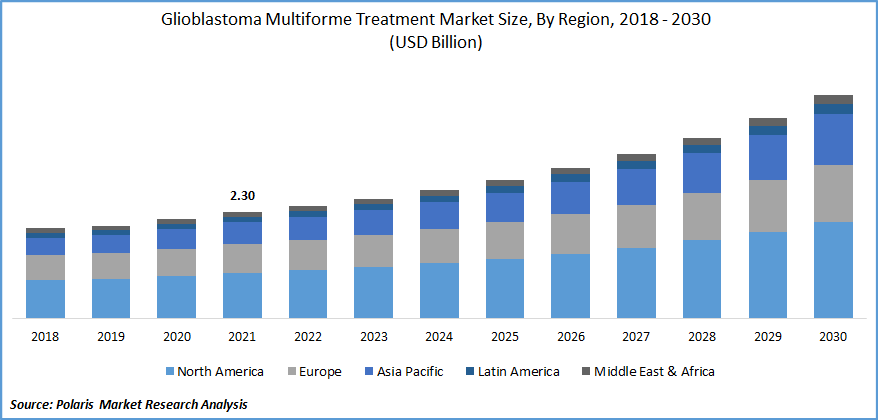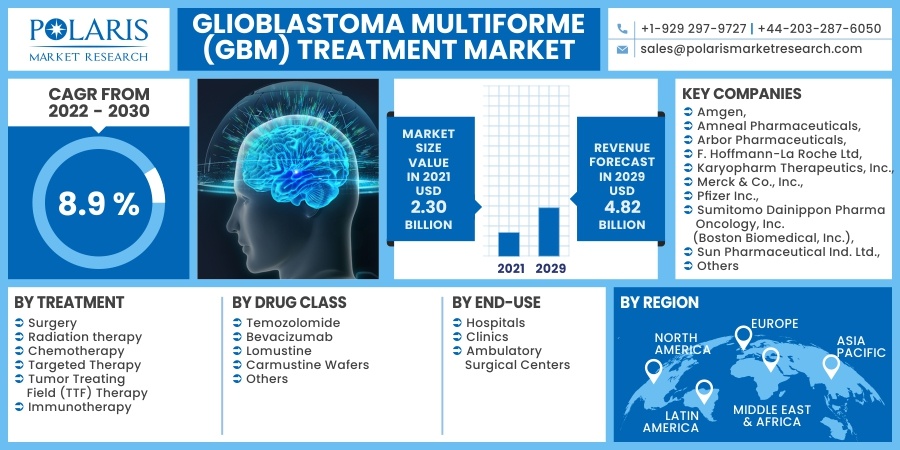
Glioblastoma Multiforme (GBM) Treatment Market Share, Size, Trends, Industry Analysis Report, By Treatment (Surgery, Radiation therapy, Chemotherapy, Targeted Therapy, Tumor Treating Field (TTF) Therapy, and Immunotherapy), By Drug Class (Temozolomide, Be
- Published Date:Jan-2022
- Pages: 110
- Format: PDF
- Report ID: PM2176
- Base Year: 2021
- Historical Data: 2018 - 2020
Report Outlook
The global glioblastoma multiforme (GBM) treatment market was valued at USD 2.30 billion in 2021 and is expected to grow at a CAGR of 8.9 % during the forecast period. The increasing incidences of glioblastoma multiforme (GBM), favorable government policies, and support from non-government bodies and NGOs for raising funds are the most significant factor that may lead the market development across the globe. In addition, the growing number of brain tumors that are one of the deadliest forms of cancer may also accelerate the glioblastoma multiforme (GBM) market demand. For instance, in 2020, the occurrence of brain and CNS cancers was approximately 308,102 worldwide, and the incidences of fatality were nearly 251,329 globally as per the Global Cancer Observatory.
 Know more about this report: request for sample pages
Know more about this report: request for sample pages
The onset of the COVID-19 has an insightful influence on the whole healthcare industry, and this also significantly affects the global economy. The imposition of lockdowns in various regions restricts them from visiting the hospitals to prevent the spread of coronavirus. This leads to the inability to access health and surgery centers for medical check-ups, radiotherapy, medical tests, and chemotherapy. Therefore, this pandemic also influences the overall pharmaceutical supply chain and obstructs the accessibility of surgery options for the sufferer of glioblastoma multiforme. Thereby, the outbreak of COVID-19 brings a considerable downfall in the glioblastoma multiforme (GBM) treatment market.
Industry Dynamics
Growth Drivers
Several initiatives are carried out by the various government and non-government bodies globally for educating people and raising awareness among them to the availability of the glioblastoma multiforme (GBM). Also, these bodies are focusing on R&D activities and better surgery options for effective healing among the patients. For instance, Ping Mobile- a mobile messaging platform, has introduced a mobile campaign to grow awareness concerning brain cancer.
Consequentially, this assists in increasing responsiveness towards the glioblastoma multiforme (GBM) and encouraging the population to contribute money for glioblastoma multiforme (GBM) research activities. Thereby, organizations like the Brain Tumour Foundation of Canada, the National Brain Tumor Society, and the Cure Brain Cancer Foundation are contributing to various awareness programs and campaigns for educating people about this state.
In the United Kingdom, a campaign was established by the Brain Tumor Research charity's member in March Brain Tumor Awareness month. The primary objective of the campaign is to increase awareness regarding the lack of financial support for brain tumor research and also assist people in better understanding brain tumors and their treatment options. Furthermore, Novocure carries out various activities to spread knowledge about glioblastoma multiforme during Brain Tumor Awareness Month. Hence, these are the major driving factor for the glioblastoma multiforme (GBM) treatment market demand across the globe.

Know more about this report: request for sample pages
Report Segmentation
The market is primarily segmented on the basis of treatment, drug class, end-use, and region.
|
By Treatment |
By Drug Class |
By End-use |
By Region |
|
|
|
|
Know more about this report: request for sample pages
Insight by Treatment
Radiation therapy accounted for the highest shares in 2021, owing to the technological breakthroughs in radiotherapy and improved survival rates. This advancement further aids more cost-effective and easy-to-use products with enhanced precision and effective drug delivery in treating diseases. Radiation therapy is predominantly offered as the initial treatment or combined with chemotherapy and surgery.
It is also productive and highly recommended for brain tumors in the event of recurrence. Thus, the growing acceptance of this surgery option in the treatment of brain tumors is contributing towards the segment growth across the globe. Further, the utilization of Temozolomide coupled with radiotherapy creates the tumor more sensitivity to radiation. This integration of therapy is more effective as compared to radiation without Temozolomide, which drives segmental growth worldwide.
Moreover, the surgery segment is projected to show the fastest CAGR in the near future. This surgery option is also penetrating for the eradication of cancer and brain tumors. Also, surgery is one of the most common treatments for GBM, followed by chemotherapy and radiation therapy. Furthermore, the growing usage of such therapy to manage the disease is anticipated to boost the segment growth over the foreseen period. Apart from this, the rise in research activities to develop new targeted therapy for the treatment of disease also drive the segment market demand over the approaching years.
Insight by End-use
The hospital segment is recorded with the largest shares in 2020 and is expected to lead the glioblastoma multiforme (GBM) market in the forecasting years. Hospitals are mainly preferred by patients for accessibility of treatment and convenience. Moreover, the rise in the number of surgeries performed and management to treat the GBM and the complexity related to the treatment are projected to drive the glioblastoma multiforme (GBM) market. In addition, the healthcare setting of hospitals is expanding at a rapid pace due to pooling investments in hospitals across developed and emerging economies.
The clinic segment is further projected to grow at a rapid rate during the foreseen period. The rising proliferation of non-invasive therapies, including radiation therapy and tumor-treating fields therapy, is also expected to reinforce the segmental growth across the world. Increasing adoption of patient-oriented surgery options, such as tumor-treating fields therapy and external beam radiation therapy, is also creating a lucrative market demand for such products in clinical settlements. For instance, Johns Hopkins Medicine provides tumor-treating fields therapy, radiation therapy, and others for the treatment of brain disorders.
Geographic Overview
Based on geographical region, North America is leading with the largest share in the global glioblastoma multiforme (GBM) treatment market in 2020 and is likely to dominate the market over the upcoming scenario. Factors such as the growing government funding initiatives and awareness program regarding disease treatment, along with, the growing FDA approval for novel drugs in the market. For instance, in October 2019, Denovo Biopharma received U.S. FDA approval for its phase 2b clinical trial that helps in evaluating an analytical combination therapy for the medication of newly diagnosed glioblastoma multiforme (GBM) patients. Furthermore, the easy availability of quality medical facilities, favorable reimbursement policies, and the rise in efforts into R&D of such drugs. Therefore, these factors may fuel the glioblastoma multiforme (GBM) market demand across North America in the forthcoming years.
Moreover, Asia Pacific is expected to grow at the highest CAGR across the globe in the approaching years owing to the factors such as rising R&D activities in the healthcare sector along with the growing presence of a large patient pool associated with targeted diseases across the region. The healthcare infrastructure in the APAC has been further shifting toward novel and innovative methods in surgery options and making technological developments to heal severe diseases, including brain tumors. Hence, it may positively influence the market demand for glioblastoma multiforme (GBM) surgery to demand that creates lucrative opportunities for the glioblastoma multiforme (GBM) market across the Asia Pacific in the near future.
Competitive Insight
Some of the major players operating the global glioblastoma multiforme (GBM) market include Amgen, Amneal Pharmaceuticals, Arbor Pharmaceuticals, F. Hoffmann-La Roche Ltd, Karyopharm Therapeutics, Inc., Merck & Co., Inc., Pfizer Inc., Sumitomo Dainippon Pharma Oncology, Inc. (Boston Biomedical, Inc.), Sun Pharmaceutical Industries Ltd., Teva Pharmaceutical Industries Ltd.
Glioblastoma Multiforme (GBM) Treatment Market Report Scope
|
Report Attributes |
Details |
|
Market size value in 2021 |
USD 2.30 billion |
|
Revenue forecast in 2029 |
USD 4.82 billion |
|
CAGR |
8.9 % from 2022 - 2030 |
|
Base year |
2021 |
|
Historical data |
2018 - 2020 |
|
Forecast period |
2022 - 2030 |
|
Quantitative units |
Revenue in USD million and CAGR from 2022 to 2030 |
|
Segments covered |
By Treatment, By Drug Class, By End-Use, By Region |
|
Regional scope |
North America, Europe, Asia Pacific, Latin America; Middle East & Africa |
|
Key Companies |
Amgen, Amneal Pharmaceuticals, Arbor Pharmaceuticals, F. Hoffmann-La Roche Ltd, Karyopharm Therapeutics, Inc., Merck & Co., Inc., Pfizer Inc., Sumitomo Dainippon Pharma Oncology, Inc. (Boston Biomedical, Inc.), Sun Pharmaceutical Industries Ltd., Teva Pharmaceutical Industries Ltd. |
